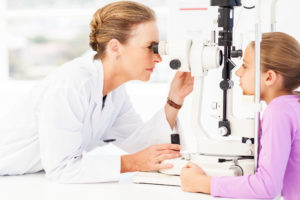sponsored content
September 15, 2021
By Grace Tseng, OD
With the increased risk of ocular diseases associated with increased axial length, emphasis should be put on monitoring axial length when myopia management is implemented to evaluate the efficacy of treatment.
 Recently, Paul Chamberlain and his colleagues analyzed the MiSight 1 day myopia control* soft contact lenses’ three-year axial length results against two previous large cohort studies – the Orinda Longitudinal Study of Myopia (OLSM) and the Singapore Cohort Study of the Risk Factors for Myopia (SCORM) measuring axial length in myopes and emmetropes of similar age groups. Axial Length Targets for Myopia Control was published in Ophthalmic & Physiological Optics, the peer-reviewed journal of The College of Optometrists (U.K.) and is available online via Open Access.
Recently, Paul Chamberlain and his colleagues analyzed the MiSight 1 day myopia control* soft contact lenses’ three-year axial length results against two previous large cohort studies – the Orinda Longitudinal Study of Myopia (OLSM) and the Singapore Cohort Study of the Risk Factors for Myopia (SCORM) measuring axial length in myopes and emmetropes of similar age groups. Axial Length Targets for Myopia Control was published in Ophthalmic & Physiological Optics, the peer-reviewed journal of The College of Optometrists (U.K.) and is available online via Open Access.
In the two large cohort studies, it was found that emmetropes also experience axial elongation from childhood until late teens at a rate 30-40% of that of myopes. The axial length growth of emmetropes is associated with an increase in body stature. Myopes, on the other hand, tend to show faster axial length elongation two to three years before myopia onset. The difficulty of interpreting axial length is compounded by the fact that axial length can vary even with the same refraction, age, and eye size.1
Chamberlain and his colleagues concluded that MiSight 1 day reduced the rate of axial elongation in children who started treatment between ages 8 to 12 years old by 52% on average† to a level similar to the physiological growth of emmetropes. Clinically, it would mean that there is likely a limit to the maximum effect of myopia control and that the reduction of axial length growth is hard to exceed 60-70%, since emmetropes still have an axial elongation rate at around 30% of that of myopes per year. However, whether myopic axial length elongation is a combination of physiological plus myopic elongation is still unknown. Thus, rather than assigning a correction factor for the axial elongation in myopes, it is much more important to note the total eye growth as it pertains to ocular health.1
Translating Research into Practice
Dr. Tseng shares two myopia management cases:
- A 9-year-old Caucasian female was started on MiSight 1 day in March 2019 and had an axial length progression rate of 0.32mm OD and 0.34mm OS the year prior with an axial length of 25.06mm OD and 24.88mm OS and a refraction of -3.00DS OD and -3.50DS OS. After a year of wear, her refraction was -3.25DS OD and -4.00DS OS with an axial length progression of 0.15mm OD and 0.17mm OS. In this patient’s case, the axial length progression rate reduced by about 50% in either eye.
- Another case of an 11-year-old Asian female with -4.00DS OD and -4.25DS OS and axial length of 25.52mm OD and 25.73mm OS was started on orthokeratology lenses in January 2019 with a previous history of axial length progression of 0.36mm OD and 0.30mm OS a year. After 1.5 years of OrthoK wear, her average annual axial length progression reduced to 0.16mm/year in OD and OS.
These cases highlight that younger age and Asian ethnicity influence axial growth rates and that myopia can be managed effectively with optical interventions.
With the increased risk of ocular diseases such as myopic maculopathy, posterior subcapsular cataract, open angle glaucoma, and retinal detachment associated with increased axial length, emphasis should be put on monitoring axial length when myopia management is implemented to evaluate the efficacy of treatment. Though there is still a lot to learn about axial length and how we can best interpret it, we as eye care providers should continue to monitor the axial length of our patients with myopia and continue to apply new and valid evidence to our clinical practice.
Grace Tseng, OD, is the previous Michael G. Harris Cornea & Contact Lens Resident at UC Berkeley School of Optometry (2020-2021) and is currently an optometrist at Silicon Valley Eye Physicians. This article is sponsored by CooperVision.
References
1 Chamberlain P, Jara PL de la, Arumugam B, Bullimore MA. Axial length targets for myopia control. Ophthalmic Physiol Opt. 2021;41(3):523-531. doi:10.1111/OPO.12812
2 Jones LA, Mitchell GL, Mutti DO, Hayes JR, Moeschberger ML, Zadnik K. Comparison of Ocular Component Growth Curves among Refractive Error Groups in Children. Invest Ophthalmol Vis Sci. 2005;46(7):2317-2327. doi:10.1167/IOVS.04-0945
3 DO M, JR H, GL M, et al. Refractive error, axial length, and relative peripheral refractive error before and after the onset of myopia. Invest Ophthalmol Vis Sci. 2007;48(6):2510-2519. doi:10.1167/IOVS.06-0562
4 Tideman JWL, Snabel MCC, Tedja MS, et al. Association of Axial Length With Risk of Uncorrectable Visual Impairment for Europeans With Myopia. JAMA Ophthalmol. 2016;134(12):1355-1363. doi:10.1001/JAMAOPHTHALMOL.2016.4009
*Indications for Use: MiSight® (omafilcon A) daily wear single use Soft Contact Lenses are indicated for the correction of myopic ametropia and for slowing the progression of myopia in children with non-diseased eyes, who at the initiation of treatment are 8-12 years of age and have a refraction of -0.75 to -4.00 diopters (spherical equivalent) with ≤ 0.75 diopters of astigmatism. The lens is to be discarded after each removal.
† Compared to a single vision 1 day lens over a three-year period














